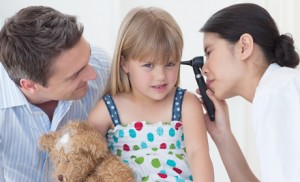The American Academy of Pediatrics has recently updated its guidelines for treating acute otitis media, the type of ear infection that’s considered one of the most common childhood illnesses. There are now more stringent criteria to make the diagnosis, which allows clinicians to prescribe antibiotics more effectively. The guidelines make recommendations for treatment with antibiotics and pain relievers or observation alone based on the child’s age and severity of symptoms. As a parent, it’s important to understand how to recognize an ear infection and how to respond appropriately.
What to Look For
Ear infections can be either bacterial or viral. “Most kids will complain of ear pain and it tends to be associated with a cold where the runny nose and coughing are the complicating factors,” says Amy Guiot, M.D., assistant professor and pediatric hospitalist at Cincinnati Children’s Hospital Medical Center. If your child complains of ear pain it is a good idea to have someone look to see what is going on.
“I’m particularly concerned about children younger than 2 years of age and those that have a high fever higher than 101,” says Guiot. If you see drainage coming out of the ear in the middle of the night, believe it or not the child will feel better because it means the pressure’s gone and the eardrum will heal all by itself.
What to Expect from the Doctor
Knowing what to expect when you see the doctor can make you feel at ease. “We look in the ear with an otoscope to see if there’s a red, bulging eardrum with pus behind it which would be an ear infection,” says Guiot. Some infections have clear fluid and are just watched but not treated. “If it’s viral you’ll find that in about three to four days the pain may be uncomfortable but then will start getting better on its own,” says Guiot. If given antibiotics, you’ll usually notice improvement in discomfort within 24 to 48 hours.
While you naturally do not want your child’s ears to hurt, sometimes there’s nothing you can do. “There has been a lot of evidence that says ear infections, even if bacterial, will go away by themselves about 75 to 80 percent of the time without any antibiotics,” says Guiot. Pediatricians tend to make a plan just in case. “We do what’s called a safety prescription where even if we see the ear infection we will say if it doesn’t get better in two days, go fill it,” says Guiot. If the child is younger than 2 years old, an antibiotic may be given if he feels particularly terrible.
Ear infections can happen to anyone and there’s no surefire prevention. “There are theories that if you nurse your baby it will decrease your risk and the pneumococcal vaccine has prevented infections,” says Guiot. Pain relievers, like ibuprofen or acetaminophen, are wonderful but you cannot give ibuprofen to kids younger than 6 months of age. Tubes are a last resort for kids who have had five ear infections in a year or three ear infections a year for two years.
The best thing you can do is support your child through the battle. “Distraction is wonderful for helping with pain, like cuddling with the baby, holding him and giving him extra attention,” says Guiot. Be cautious with decongestants and know that a cool mist humidifier doesn’t help an ear infection. “At the first sign of something hurting you don’t need to run to the doctor … it’s OK if you cannot get in at 2 a.m. to wait because it will not change a whole lot, since most ear infections get better on their own,” says Guiot.





